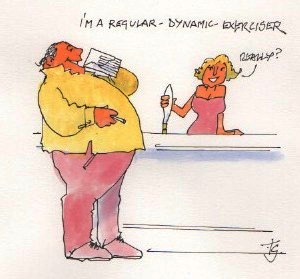HOW MUCH EXERCISE DO YOU TAKE
One way for doctors to uncover a patient’s drinking habits goes like this: ask the patient how much he (it is usually a he) drinks and double it. Ask his wife how much he drinks and halve it. Add the two figures together and divide by two and this gives you the answer. This also works for cigarette smoking and, I suspect, exercise as well. When answering lifestyle questions, everyone is susceptible to “social desirability bias”.
Measuring physical activity
I have mentioned previously that there is a hierarchy of measures of exercise performance. Using electronic devices such as pedometers or accelerometers is the most reliable, followed by measuring physical fitness. Responses to questionnaires comes a poor third.It is generally reckoned that people believe that they take about twice as much exercise as they really do (see my Blog of July 9th “Exercise, obesity and self-deception”).
This can make a big impact on the results of surveys of recommended exercise targets and the percentage of the population which meets them. In 2008 the Health Survey for England (HSE) sent questionnaires on exercise to a large sample of the adult population. Based on the participants’ self-reported data, 39% of men and 29% of women met the exercise recommendations of the Chief Medical Officer. That year the HSE used accelerometers (a sort of sophisticated pedometer) to record information on the frequency, intensity and duration of physical activity in one minute “epochs” – showing accurately the actual daily activity of their subjects over a period of one week. Based on the results of the accelerometer study, 6 per cent of men and 4 per cent of women achieved the government’s recommended physical activity level – just 15% of the level of compliance indicated by individuals’ own questionnaire responses – revealing a staggering level of either self-deception or just downright lying!
Time-use diaries
I have just been introduced to a further method of measuring activity by a book reporting the researches of Jonathan Gershuny and Oriel Sullivan1. They applied time-use diaries to record the sequence of what people did over a specific day, together with approximate clock times. Among the plethora of activities (or inactivity) studied were times spent in physical activity. They found that the responders’ assessment of the amount of exercise they thought they took was about three times greater than the real amount revealed in their diaries. The researchers uncovered a large number of fascinating facts about physical activity as well as all the other activities of daily living. Overall energy expenditure rose to a maximum between the ages of 30 and 50 and then fell progressively. The highest levels were found in those in work but without higher education – ie manual workers. The amount of energy spent in purposeful exercise was miniscule.
Total energy expenditure
A clear message from the findings of the time-use diaries is this. Even for those who take a lot of exercise, it is the accumulation of energy spent on the rest of daily activities which accounts for far the larger part of total expenditure.
The authors also found a clear association between activity and wellbeing. People with the lowest levels of physical activity reported the lowest assessment of their state of health. Those with higher levels of physical activity had substantially and statistically significantly higher levels of positive assessments of their health.
I strongly commend this book – a great read and maybe a suitable Christmas present for the sociologically curious.
Lessons learned?
The main lessons are that we are all far too inactive – and that we cannot believe the results of studies based on questionnaire surveys. Or can we? Presuming that everyone answers such questionnaires with the same degree of inaccuracy, the association between physical activity and health holds good – at lower levels of activity than may be believed.
- Gershuny J, Sullivan O. What we really do all day. Insights from the Centre for Time Use Research. Pelican Books London 2019.
Subscribe to the blog
Categories
- Accelerometer
- Alzheimer's disease
- Blood pressure
- BMI
- Cancer
- Complications
- Coronary disease
- Cycling
- Dementia
- Diabetes
- Events
- Evidence
- Exercise promotion
- Frailty
- Healthspan
- Hearty News
- Hypertension
- Ill effects
- Infections
- Lifespan
- Lipids
- Lung disease
- Mental health
- Mental health
- Muscles
- Obesity
- Osteoporosis
- Oxygen uptake
- Parkinson's Disease
- Physical activity
- Physical fitness
- Pregnancy
- Running
- Sedentary behaviour
- Strength training
- Stroke
- Uncategorized
- Walking



<ay I pose a Question?
What is the effect on longevity and health, of living in a house with stairs [to climb frequently] rather than a bungalow?
What an interesting question! I am unaware of any research on this. Of course having to climb stairs regularly must be much healthier than living on one floor. Any statistics would be very difficult to interpret because of confounders such as stair lifts in houses or moving to a bungalow because of ill health. I have always done my best to discourage the use of stair lifts.
Hugh